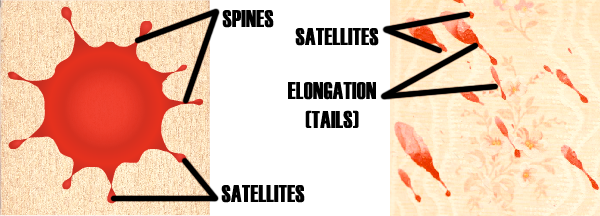7/11/19- While forensic entomology is incredibly useful in determining time of death in a victim, that requires the presence of a body. Forensics isn’t all about analyzing a body (albeit it’s obviously very crucial to the concept), it’s also about determining facts about a crime. This includes doing so without a body present, putting together evidence like pieces of a really, really troubling puzzle. This is where Blood Spatter analysis comes in handy.
I know, I know, I thought it was ‘blood splatter‘ too. But that’s not correct, as the word ‘spatter’ means drops on a surface. Blood left behind at a crime scene isn’t always going to be a splatter pattern; but there sure is heck gonna be ‘drops on a surface’ when blood is present
Just by looking at the blood left behind, a whole lot of information is left for the trained eye to take in. It can determine the force of the impact, what weapon was used, where the assailant was standing, where they struck the victim (down to the very angle), whether the victim was moving or not, and where the victim was standing/sitting/lying down. And that’s just for the blood that you can see. Some blood can’t be seen with the naked eye (called latent) and thus need a chemical agent such as “Luminol” to reveal the hidden evidence. So, this means that even if the murderer were to clean up after themselves, blood can still be present at the crime scene, leading law enforcement in on their trail.
It’s hard to get away with murder these days; it’s not what most people would call an acceptable pass time anyway
I was tasked with a few blood spatter experiments (not using real blood, thank goodness), the most prominent being figuring out how different angles affect a single drip of blood on a smooth surface. The biggest hiccup in this experiment was the fact that the stand in blood didn’t have the same density as real blood, so it affected this severely. But I was able to determine that as the angle of the surface increases, the ‘length’ of the drip trail increases, but it’s width decreases. Also, blood on a smooth surface is more intact, or uniform, in structure and appearance.
I learned a lot of blood spatter terminology , like ‘spine’ and ‘satellite’

Here’s an illustration to better explain this
Also, just by looking at these spines and satellites, the blood spatter analyzer can determine from what height the blood dripped from.
Blood stains caused by stabbing are called “sharp force injuries” and are done with an object with a small surface area, like a knife or ice pick. These stains are more linear in appearance.
Gunshot wounds leave a sort of “mist” of blood behind
Blunt force injuries, caused by a bat, hammer, or some other object you can throw around, leave drops of different sizes.
Gosh, even without a murder weapon present, experts STILL have a pretty clear idea of what was used; as if people on the lamb had enough to worry about.
Speaking of hooved creatures like lambs, the ranch is now home to a juvenile male javelina; who was hit by a car on the highway, of course. The body sits in a cage a ways away from my squirrels to ensure the insects that keep traveling back and forth don’t get distracted by the fresh kill.
I’ve managed to become the enemy of every vulture on the ranch by caging up so many potential meals. Especially a large, juicy javelina.
Let’s hope the coyotes don’t hate me, or we might have a problem!
P.S.
When I went to go help move the new test subject to a different location, I ran into this guy
Tom Holland who?
Let’s hope he made it home safely, because I saw a female tarantula hawk wasp hanging around. Although the adults of this species feed on nectar like docile butterflies, by the very conspicuous name you can tell that this wasp isn’t a friend to spiders, more specifically the female ones; the mother wasp will find a spider, paralyze it with her sting, drag it back to her burrow, and lay her eggs on top of the poor spider. Then, the babies will hatch and eat the spider. While IT’S STILL ALIVE.
Where’s Sigourney Weaver when you need her? 👽

There are no comments published yet.